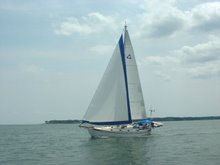The National Forest Service has escalated the fire risk from 'Very High' to 'Extreme'. It's dry, dry, dry out here. There were fire alerts for the North Cascades National Park and we were hoping we wouldn't have a rerun of our experience in Glacier. So far, so good.
Looking at the map, we decided to deviate from our planned route to the North Cascades National Park, leaving Rte 20 to take yet another beautiful scenic route through the Colville Confederated Tribes Reservation. It took us south through the Sanpoil River valley which was stunning. A high sided, magnificent rocky canyon with the Sanpoil River meandering down the narrow, lush, green valley. We eventually rose out of the valley and travelled up through high range land. We barely saw any other cars as we headed back north to rejoin Rte 20. (Sorry no pictures)
This land was given to the few remaining members of 12 tribes after they had been forcibly moved around, starved, and humiliated for many years, like so many other American Indian tribes.
We have spent a lot of time in 2nd (and sometimes 1st) gear going over passes from 3,200 – 5,600 feet above sea level, but after seeing the covered wagons that made this same trip almost 200 years ago we feel like we are flying. Wheee!
Julie decided to take a dip in the lake one afternoon, but she only made it up to her knees - there's a reason it's called a glacial lake! Brrrr!!
We decided to head east back over the Cascades on Rte 20 again for our second trip over Washington Pass at 5,476' above sea level.
Welcome back to 1st gear!! The reasons for our decision to backtrack were first, because we had missed a lot on our way in, and second, so we could take yet another scenic route we didn't want to miss.
 Town of Winthrop
Town of WinthropSo we headed south to rejoin Rte 2. As we drove we started smelling smoke and by the time we reached Chelan it was thick and acrid. We stopped for groceries and asked where the fire was, hoping they wouldn't say it was along our route. We learned that it was at the top end of Lake Chelan, 50 miles NW of us, but the wind was bringing the smoke right down to us. There was no chance of it reaching us so we headed up Rte 2 back up into the mountains for a nice smoke-free night.
The next day we stopped at 2 awesome roadside interpretive trails. The first was the Iron Goat Trail which follows the abandoned Great Northern Railway through Stephen's Pass. More info on this wonderful trail can be found at "http://www.irongoat.org/history.html". We got to walk beside the concrete backwalls that are the remains of the snowsheds built to protect trains and tracks from avalanches in the winter.
The second was Deception Falls, a lovely walk through a beautiful forest to another dramatic waterfall.


We then dawdled our way west to Seattle to spend a few days with our cruising friend Connie.
At one point we were following a small biplane on a trailer with wings folded along the sides – very cool.
























































